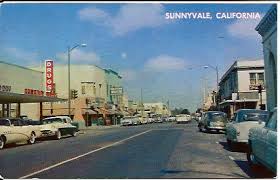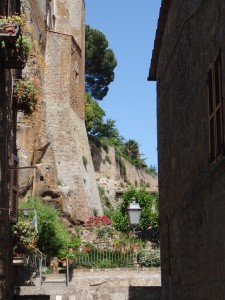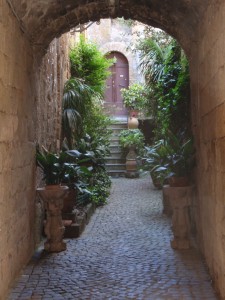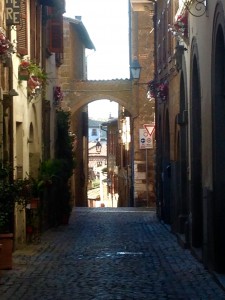I grew up in Sunnyvale, California in the 1950’s. When I was born, its population was about 5,000. By the time I turned ten, that had risen to nearly 50,000. When I left for college, there were more than 120,000. Those surges of population were a kind of invasion, we were colonized by technology.
The Sunnyvale I knew as a child was rural and agricultural. It rests in the heart of the Santa Clara Valley, which enjoyed (and probably, in a highly theoretical sense, still enjoys) some of the best conditions for year-round sustainable horticulture in the world. This was conveniently ignored when Lockheed began hiring in the thousands and real estate values shot up to previously inconceivable levels. The Sunnyvale I left when I was 19 was the aging core of a what had managed to survive the blitz, surrounded by tacked-on “subdivisions”.
My parents continued to live in the house they raised me in through retirement, old age, and decline. They both died in that house. It was recently taken down, along with the one next to it, so that a not-terribly-unattractive office building could be erected. There are pockets of the town I knew as a kid that still remain, but many of the older homes have either been replaced with more impressive ones, or enlarged to be less incompatible with the rational use of such expensive land.
The downtown I walked to almost every day when I was young was torn down in 1980, replaced by a Town Centre, which in turn was torn down about 25 years later, long after it had proven itself unsustainable. It is being replaced by an  as-yet-to-be-completed “planned downtown.” The single block from before the devastation of 1980 that was allowed to remain is the only part of the downtown area that continued to flourish.
as-yet-to-be-completed “planned downtown.” The single block from before the devastation of 1980 that was allowed to remain is the only part of the downtown area that continued to flourish.
I can’t go home, almost none of it exists anymore.
But I enjoyed growing up there.
I walked to school from the age of six. I walked to church. I walked to hang out in stores and admire their goods, and no one ever questioned me about it. There were shops run by people who owned, loved, and created them. There where department stores like Penny’s and Hart’s, manned by the same sales staff for years on end who knew my evolving tastes and helped to inform them. When I started high school, the walk was longer but still possible. Part of it took me through a cherry orchard, then Mathilda Avenue was  pushed through, and I followed the same path on a sidewalk still surrounded by trees.
pushed through, and I followed the same path on a sidewalk still surrounded by trees.
My mother died in 2007 and with her passing my Sunnyvale walks ended. That was okay, they had become exercise. There weren’t many places left to walk to, or when you could, the walk had grown so unpleasant by proximity to roaring lines of traffic that it hardly seemed worth the effort. But unless I move, regularly, I want to jump out of my skin, so in my mother’s final years I walked in S and U curves, up and down blocks, identifying changes, recalling friends and family and friends of family and where they used to live and work.
Now, until late spring, I’m living in Orvieto, Italy. It’s a hill town on a volcanic outcropping surrounded on all sides by cliffs that drop away into a green valley.
 My days are a luxury. I can write without distraction, settled into an pleasant rhythm made possible by retirement income. I don’t need a car because I never have to leave town. Should that change, I can catch a train. I live on a fringe, only gently touched by the daily struggles that people here, as anywhere, are faced with. The thrum of modern life attracts with a similar pull as in other less insular towns, but I can ignore it.
My days are a luxury. I can write without distraction, settled into an pleasant rhythm made possible by retirement income. I don’t need a car because I never have to leave town. Should that change, I can catch a train. I live on a fringe, only gently touched by the daily struggles that people here, as anywhere, are faced with. The thrum of modern life attracts with a similar pull as in other less insular towns, but I can ignore it.
I walk often. Every walk has a destination, or can be made to have one. I’m getting to know the people who own the shops and restaurants and coffee bars, and whose personalities they reflect. Everywhere, I see people I’ve met; on the street, at the bakery, the wine shop, the chocolate shop, in the piazzas. A little longer walk will take me into the countryside where there are orchards and gardens that help to feed the town. There is an ease to life here that has been so familiar, but I’ve not been able to identify why.
Today, I suddenly saw the connection between Orvieto and the Sunnyvale of my childhood. It isn’t so strange that it took me two months to find it, because visually the two places could not be more different. Sunnyvale was founded in what may have been, conservatively speaking, Orvieto’s twenty-fourth century. Its houses have always been separated by yards with lawns and fences and trees. In Orvieto, all that gardening is modestly concealed behind stone walls.

Sunnyvale grew out of a tradition rooted in places like Orvieto. In Sunnyvale, the tradition was abandoned in the rush towards growth – perhaps hardly even noticed – whereas Orvieto seems acutely aware of how fragile its genre of community is within the larger scope of modern city life. While many people here express some pride in the vast Coop Supermercato in the lower part of the city called Orvieto Scalo, there’s also (thankfully) an awareness that such enterprise can suck the life out of an old-style town, dry it up before anyone knows what happened.
I hope that awareness is more than a product of my eager imagination, because what Orvieto, and places like it, have managed to sustain encourages human dignity in ways that Sunnyvale, impressive as its growth and expansiveness have been, neglects. The ready ease that still exists in these towns is difficult to find, let alone maintain, in the Sunnyvales of the world.
Ever since my first experience of the Italian city forty years ago, I’ve been trying to incorporate the ease that draws me here into my life in the States – or at least simulate it – with mixed results. I’m not sure it can be done at all, but it’s worth a try. Much to their credit, a few of the communities surrounding Sunnyvale have preserved their  downtowns. That helps. But ease cowers from traffic and institutionalized commercialism, and urban spread depends on those. In such environments it takes deliberate effort to lure ease into daily life; an interesting conundrum.
downtowns. That helps. But ease cowers from traffic and institutionalized commercialism, and urban spread depends on those. In such environments it takes deliberate effort to lure ease into daily life; an interesting conundrum.
As years click away, and the scope of opportunity narrows simply because the time left to accomplish things has narrowed, the impulse to return home grows stronger. Orvieto, echoing the quiet melodies that kept Sunnyvale local in the 1950’s, feels like home. Half a world away, I relax back into a pace so familiar that it almost flows in my bloodstream. I’m grateful to be here. Come visit for more than a week or two, and you may find something similar.